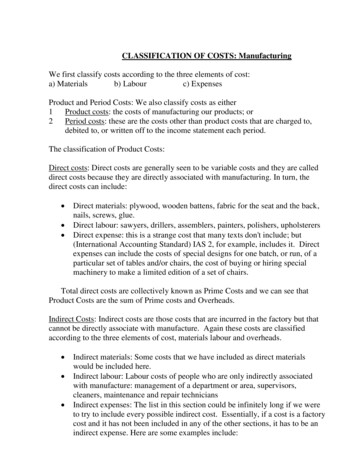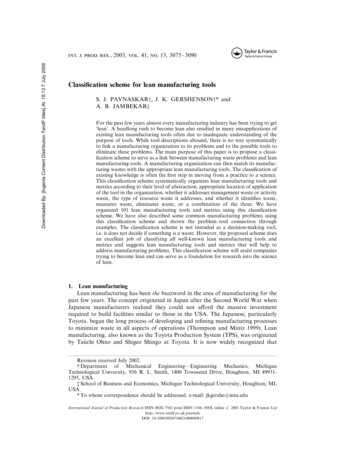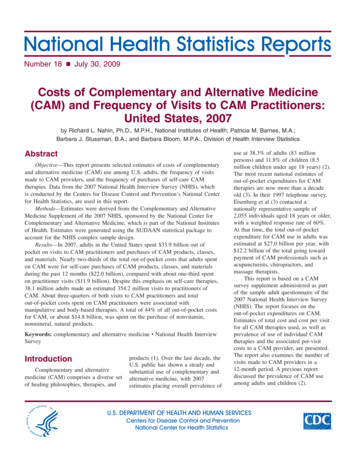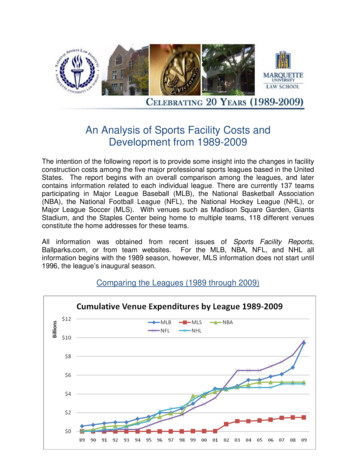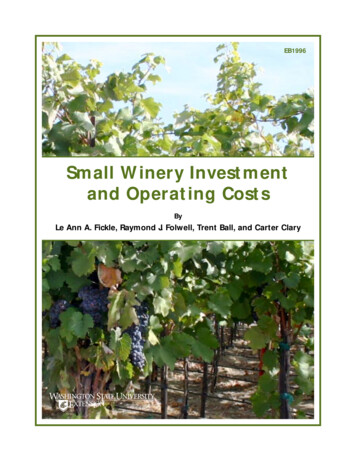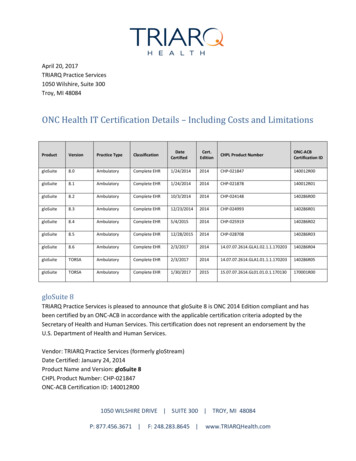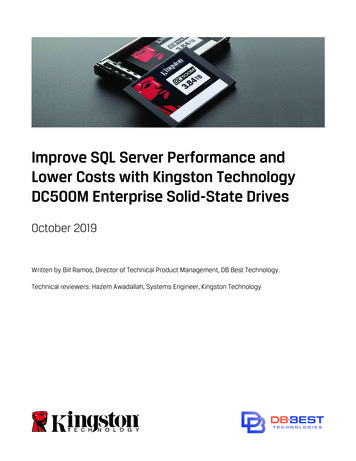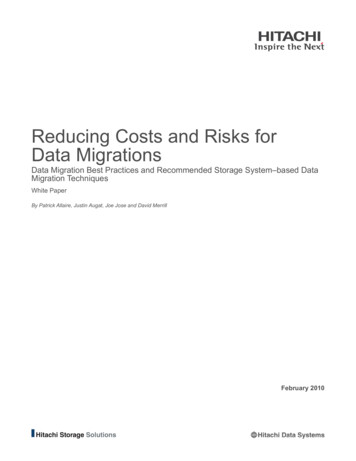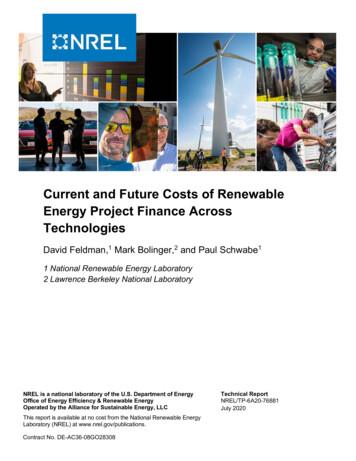
Transcription
Management AccountingClassification of Manufacturing Costs and ExpensesIntroductionManagement accounting, as previously explained, consists primarily of planning,performance evaluation, and decision‑making models useful to management inmaking better decisions. In every case, these tools require cost and revenue infor‑mation. A basic assumption of management accounting is that it is the responsibilityof the management accountant to provide the needed cost and revenue information.Consequently, the management accountant needs a complete understanding of thedifferent types of costs required by the various models. In Figure 4.1, the major costsassociated with each management accounting tool is listed.In management accounting, as in financial accounting, it may be said that a majorbuilding block in the conceptual foundation is cost. Both the financial and manage‑ment accountant must have a sound understanding of the varied and complex rami‑fications of cost. From a financial accounting viewpoint, a faulty understanding ofcost may cause financial statements to be incorrectly prepared. From a managementaccounting viewpoint, an inadequate understanding or use of costs will result in poordecisions.There are two broad aspect of the term cost that needs to be understood: costclassification and cost behavior. Cost classification refers to the separation of costsinto categories for proper preparation of financial statements or for use in deci‑sion‑making models. Cost behavior refers to the effect that volume (production orsales ) has on total expenses or costs. In this chapter, both aspects will be discussedin some depth. 51
52 CHAPTER FOUR Classification of Manufacturing Costs and ExpensesCost ClassificationIn accounting, the term cost refers to the expenditure or sacrifice made to acquiresomething of value. In financial accounting, all transactions are recorded in termsof historical cost; that is, the money expended or to be expended at the date of thetransaction. The monetary value associated with an asset acquired is said to be itscost. Cost is the sacrifice made in resources to acquire another resource. Cost ismeasured in monetary units which in the United States is the dollar. For example, amachine is purchased by paying 4,000 in cash and trading in an old machine havinga sales value of 1,000. The cost of the new machine is 5,000 because resourcesworth a total of 5,000 were given in the exchange. Stated differently, resourcesworth 5,000 were sacrificed.Figure 4.1ToolsFlexible BudgetCost‑volume‑profit analysisDirect costingBudgetingVariance analysisIncremental analysisSegmental reportingInventory modelsPresent value modelsCost Information RequiredFixed and variable costsFixed and variable costsFixed and variable costsPlanned data, fixed and variable costsFixed and variable costsEscapable , opportunity, relevantIndirect costs, direct costsPurchasing cost, carrying costCash inflows, cash outflowsDepending on the type of activity and the passage of time, the cost of an asset inaccounting can be classified in several ways. Proper financial reporting and correctdecision‑making require an understanding of the different ways in which costs canbe classified. In Figure 4.2 is a list of costs that pertain to both financial statementpreparation and decision‑making analysis.For purposes of management accounting, there are three important dual classifica‑tions of cost that require some understanding: Expired and unexpired, manufacturingand non manufacturing, and fixed and variable. These three classifications aresomewhat interrelated, particularly concerning financial statements.Expired and Unexpired CostsExpired costs or expenses are the used up value of assets. Expired costs arealways shown on the income statement as deductions from revenue. Expired costsmay be thought of as that portion of the asset value benefitting current operations.It is helpful to think of expired costs as former assets values. To illustrate, suppliesexpense is an expired cost. The cost allocated to supplies expense, of course, isthe used portion of supplies, an asset. The relationship between asset values andexpired costs is further illustrated in Figure 4.3.
Management AccountingFigure 4.2Financial Statements Cost ConceptsDirect and indirectPrimeJointFixed and variableManufacturing and non manufacturingExpired and unexpiredExpensesFixed and variable expensesManagement Accounting Cost Concepts(Decision‑making Cost Concepts)Relevant and irrelevantEscapable and inescapableSunkFixed and variableOpportunity and sunkIncrementalDirect and indirectMixed, semi-variableCarrying cost, purchasing costManufacturing Costs/ExpensesThe difference between a cost and an expense is frequently misunderstood.Because the terms variable costs and variable expenses will be used later in thischapter, and also throughout this book, the difference in meaning between a cost anda expense will now be clarified.Technically, there is a difference between a manufacturing cost and a manufac‑turing expense. The term manufacturing costs usually refers to material used, directlabor incurred, and overhead incurred in a manufacturing business. Material used,direct labor, and manufacturing overhead at the time incurred are not expenses; ratherthey incurred costs. In the manufacturing process, material, labor, and overhead donot expire; rather through manufacturing activity they become transformed from onetype of utility to another.In a manufacturing business, the accountant will debit work in process for mate‑rials used, direct labor incurred, and manufacturing overhead. Since work in processis an asset account, it would not be logical to regard material used, direct labor, andmanufacturing overhead as expenses. Expenses cannot be transformed back intoasset values.Figure 4.3Asset Values and Related ExpensesAssetAccounts receivableFinished goodsPrepaid insuranceSuppliesBuildingExpiredBad debts expenseCost of goods soldInsurance expenseSupplies expenseDepreciationManufacturing costs, however, do eventually become manufacturing expensesMaterial used, direct labor incurred, and manufacturing overhead are first recorded 53
54 CHAPTER FOUR Classification of Manufacturing Costs and Expensesin inventory accounts (work in process and finished goods) and then become anexpense when finished goods are sold. In a manufacturing business, only the costof goods sold account can properly be called a manufacturing expense. Prior to thesale of finished goods, all manufacturing expenditures remain as unexpired costs.In order to understand the transformation of manufacturing costs into manufacturingexpenses, you should fully understand the flow of cost as taught in cost accounting.The flow of cost diagram is shown in Figure 4.4.The term, variable cost, then primarily refers to the manufacturing costs that arereflected in the inventory accounts: materials, work in process, and finished goods.The term, variable expenses, refers to cost of goods sold and to other variablenon manufacturing expenses such as sales people’s commissions. As a studentof management accounting, you should understand, however, that the two terms,variable expenses and variable costs, are sometimes used interchangeably. Somewriters use the term variable costs to include variable expenses. The technical differ‑ence is ignored because the theory underlying the use of variable expenses is thesame as for variable costs.There is one instance in which manufacturing costs and manufacturing expenses(cost of goods sold) are the same in amount. When sales equal production, that is, allunits manufactured are sold, then manufacturing costs (materials used, direct laborincurred, and manufacturing overhead incurred) and the manufacturing expense (costof goods sold) are equal. Under these conditions, all manufacturing costs includingfixed manufacturing overhead incurred will be included in cost of goods sold.In terms of financial statements, manufacturing costs appear on the cost of goodsmanufactured statement while manufacturing expenses are shown on the incomestatement. However, the amount of manufacturing costs are not necessarily reportedon the income statement in the period incurred. Some of the current period manufac‑turing cost may still reside in finished goods inventory until the inventory is sold.Figure 4.4 Flow of Manufacturing CostFinished GoodsMaterialsDirect LaborWork in ProcessManufacturing OverheadNote: The flow lines denote journal entries at the end of theaccounting period to transfer cost.Cost of Goods Sold
Management AccountingManufacturing and Non Manufacturing CostsThe distinction between manufacturing and non manufacturing costs is importantbecause this dual classification is reflected in different types of financial statementsfor the manufacturing business: the income statement and the cost of goods manu‑factured statement. The cost of goods manufactured statement shows all the currentperiod manufacturing costs while the income statement shows all the current nonmanufacturing expenses. In order to understand the direct relationship of the incomestatement and the cost of goods manufactured statement, it is necessary to under‑stand the distinction between manufacturing and non manufacturing costs.Manufacturing costs may be simply defined as materials used, direct laborincurred, and manufacturing overhead incurred. These are the costs that are foundon the cost of goods manufactured statement. Non manufacturing costs (techni‑cally, expenses) are those expenses commonly called selling and administrative.These are the expenditures incurred in the current period directly for the benefit ofgenerating revenue. Non manufacturing expenses should not be included in the costof inventory. The term is somewhat misleading because the “cost” part of the termimplies unexpired costs when it fact it has reference to expenses. Since “non manu‑facturing costs” are, in fact, expired costs (expenses), then technically a better termwould be “non manufacturing expenses.”After some costs have been classified as manufacturing, they are normally furtherclassified as direct and indirect. Materials used in the manufacturing process areeither used directly or indirectly. Direct material is material that becomes part of thefinished product and, therefore, significantly adds to the weight or size of the product.If the final product, for example, is a wooden chair, then the wood used to make thelegs, seat, and back is a direct use of material. Materials such as glue and screws,usually not significant in amount, are often regarded as an indirect use. Also materialissued but not becoming a part of the final product and used for manufacturing objectssuch as saw horses or shelves to store paint or other incidental materials would beregarded as an indirect use of material.In a similar manner, factory labor is normally classified as either direct or indirect.Consequently, two types of labor are recognized: direct factory labor and indirectfactory labor. Direct factory labor is the cost of labor incurred while work is done onthe product itself. Normally, in one way or another, direct labor affects the physicalappearance of the product. Some factory workers do not actually work on the productitself but provide services necessary to the over-all manufacturing process. Janitorialservices, repair and maintenance service, supervision of direct workers, and computersupport are examples of labor incurred that would be regarded as indirect.The significance of classifying material and labor as an indirect cost is this: indirectmaterial and indirect factory labor are recorded as manufacturing overhead and,therefore, becomes a part of the cost of the final product through the use of overheadrates. The recording of direct and indirect manufacturing cost may be illustrated asthe following journal entry: 55
56 CHAPTER FOUR Classification of Manufacturing Costs and ExpensesDateAccountsDec. 31Work in process (direct material)100,000Work in process (direct factory labor)250,000DebitCreditManufacturing overhead (indirect material)20,000Manufacturing overhead (indirect labor)50,000Materials inventory120,000Factory labor300,000Although the classification of costs as manufacturing and non manufacturing isvery important in preparing financial statements, this distinction is not essential froma decision‑making viewpoint. The important point is that the tools of managementaccounting are equally important in both categories of cost. Important decisions inboth areas can benefit from the use of management accounting tools. Figure 4.5shows examples of specific decisions in both classifications.Fixed and Variable CostThe most volatile variable in a business is considered to be volume. A funda‑mental fact of all businesses is that some costs change (increase or decrease) withchanges in volume (activity). The costs or expenses that change with volume arecalled variable while those that do not change with changes in activity are calledfixed. The classification of costs as fixed and variable is by far the most useful andhelpful classification of costs in management accounting. Furthermore, the recogni‑tion of fixed and variable costs has resulted in several mathematical models useful inanalyzing cost data for decision‑making purposes.Some decisions such as a decrease in price or an increase in advertising canhave an immediate impact on volume. In most instances, management will want toFigure 4.5Relationship of Cost Classification and Decision-makingClassification of CostsExample of DecisionsManufacturingMaterialLaborManufacturing OverheadSuppliers, quality of materialWage rate, number of hoursCost of equipment, repairs and maintenanceNon Manufacturing Costs (expenses)Sales People CompensationAdvertisingStaff salariesCommission rateMedia, advertising budgetSalary, working hours
Management Accountingtest decisions before execution. In management accounting, a number of planning,eva
Direct costing Fixed and variable costs Budgeting Planned data, fixed and variable costs Variance analysis Fixed and variable costs Incremental analysis File Size: 506KBPage Count: 12
